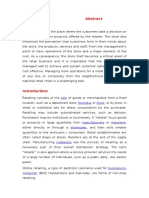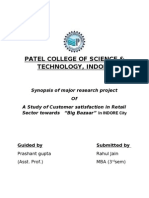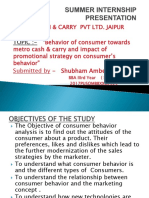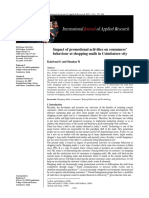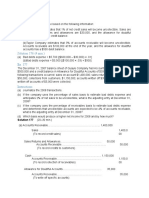JMIJMM Vol2 Iss2
JMIJMM Vol2 Iss2
Uploaded by
profdrnrkCopyright:
Available Formats
JMIJMM Vol2 Iss2
JMIJMM Vol2 Iss2
Uploaded by
profdrnrkOriginal Title
Copyright
Available Formats
Share this document
Did you find this document useful?
Is this content inappropriate?
Copyright:
Available Formats
JMIJMM Vol2 Iss2
JMIJMM Vol2 Iss2
Uploaded by
profdrnrkCopyright:
Available Formats
VOLUME - 2 ISSUE -2 MAY, 2012 ISSN:2230-701X
JM INTERNATIONAL JOURNAL OF MARKETING MANAGEMENT
CONSUMER PERCEPTION TOWARDS STORE IMAGE & STORE
LOYALTY IN THE COIMBATORE DISTRICT
Dr.R.Karuppasamy
Director, Dept. of Management Studies SNS College of Technology, Coimbatore.
Mr.N.Ramesh Kumar
Research Scholar
Asst. Professor, Nehru College of Management, Coimbatore.
e-mail: ncmrameshkumar@gmail.com
Mobile: 9442606585 & 9787836757
Abstract: Retail is India’s largest industry, accounting for over 15per cent of
the country’s GDP and around 12 per cent of the employment.. It has emerged
as one of the most dynamic and fast paced industries with several players
entering the market. The revolution in retailing industry has brought many
changes and also opened door for many Indian as well as foreign players. In a
market like India there is a constant clash between challenges and opportunities
but chances favour those companies that are trying to establish themselves. So
to sustain in a market like India companies have to bring innovative solutions.
Indian market has potential to accommodate many retail players, because still a
small proportion of the pie is organized. This paper discusses the emerging
business of retail sector and also the customer perception towards store image
and loyalty. Gaining competitive advantage in retailing requires knowledge of
the attributes consumers use to evaluate stores and an understanding of why
these attributes are important for retail formats.
Introduction
Retailing in India is gaining attention like never before. Organized retailing especially is
creating euphoria amongst Indian consumers drawing them into malls and trade areas in huge
numbers. Retailers are offering to the customer enjoying and create unique shopping
experiences. Retail is India’s largest industry, accounting for over 15per cent of the country’s
GDP and around 12per cent of the employment. It has emerged as one of the most dynamic and
fast paced industries with several players entering the market. Western-style malls have begun
appearing in metros and second-rung cities alike introducing the Indian consumer to a shopping
experience like never before. India’s vast middle class and its almost untapped retail industry
are key attractions for global retail giants wanting to enter newer markets. The organized retail
sector is expected to grow stronger than GDP growth in the next five years driven by changing
lifestyles, strong income growth, better products and shopping options, and favorable
demographic patterns. In modern retailing, a key strategic choice is the format. Innovation in
© JMINTERNATIONAL PUBLISHERS Page 88
VOLUME - 2 ISSUE -2 MAY, 2012 ISSN:2230-701X
JM INTERNATIONAL JOURNAL OF MARKETING MANAGEMENT
formats can provide an edge to retailers. Organized retailers in India are trying a variety of
formats, ranging from discount stores to supermarkets to hypermarkets to specialty chains.
Adding one more thing the organized retail sector is , notably, organized retail market has also
registered very rapid growth in India. ETIG (Economic Times Intelligence Group) estimated
the size of the organized retail industry at about Rs.16,000cr in 2001-02. We will estimate the
retail industry will cross the Rs.60,000cr sales mark by year 2017. The industry is growing at
the rate of about 19-22% per annum. A Study of Consumer Perceptions towards Store Image &
Store Loyalty in Coimbatore district. This study helps to understand the consumer perception
towards retailing in the Coimbatore district. The current study is a focus on the scope of
retailing in new business environment by assessing the respondent’s demographic profile, their
attitude and preference towards different types of store selection. .
Review of Literature
Leonard Lodish (1982) describes components of marketing strategy development through
DSS for retailing. The goal of the DSS system is to improve marketing strategy and marketing
resource allocation for a large multi store, multi department retailer. However he warns that
effectiveness of the system will depend on willingness on the part of managers to adapt. DSS
evolves constantly as its users and developers interface, generate problems, questions and
desires.
Little (1989) suggest that DSS must be simple, robust, easy to control, adaptive, as complete as
possible and easy to communicate with.
Success of retail depends upon Store image formed by the customer in their mind. Retail
store image can be described as the series of mental pictures and feelings that a store evokes
within the beholder. In other words it is the overall perception of customers about a Retail
store which is the result of Physical characteristics of a store such as its brand name, logo,
symbol, layout, presentation, signing, displays, entrances, events, flooring, cleanliness etc as
well as other variables related to employee behavior within the store image has been defined
and operationalized in a myriad ways. Martineau, 1958 was among the first to link store image
or what he called as personality of the store, to the image that a shopper has of oneself.
Martineau suggested that a shopper is unable to differentiate based only on price amongst
various grocery stores and would tend to shop at that store which is congruent with the self
image. “The shopper seeks the store whose image is most congruent with the image she has of
herself. Some stores may intimidate her; others may seem beneath her. A store may be
acceptable for one type of goods and not for others. A model proposed by Huff, in 1964 states
that customer patronage is directly proportional to utility factors given by square feet and
inversely proportional to disutility factors given by physical distance. Applebaum, 1966
studied that the limits to enhancing loyalty can essentially be seen as the limited centripetal pull
of a store/shopping centre.
Hubbard, 1978 researched on location-related variables to conclude that customers give more
importance to location related variables in analyzing both trade areas and retail patronage
behavior. These studies most often count the benefits of locating a store in a shopping
centre/mall to increase the store ‘destination’ traffic rather than just stay with the convenience
pull. The same work was further supported by Gautschi, 1981 to determine that shopping
© JMINTERNATIONAL PUBLISHERS Page 89
VOLUME - 2 ISSUE -2 MAY, 2012 ISSN:2230-701X
JM INTERNATIONAL JOURNAL OF MARKETING MANAGEMENT
centre traffic more accurately than single store traffic. The Huff model has subsequently been
studied by introducing trade overlap areas for effects on store patronage. (Bucklin, 1971).
Generically speaking, these studies have resulted in the formation of the Theory of
Gravitational Pull in the field of retailing patronage studies. Moore and Barry, 1969 fount out
that apart from distance, several other factors such as Income and social class perceptions have
also affect retail centre patronage decisions.
Arnold et al.1983, Craig et al. 1984, Louviere and Gaeth, 1987 studied the effect of product
characteristics on store patronage. They concluded that within a given trade area, the
uniqueness of assortment is a way of influencing store loyalty and patronage. In consumer
priorities, assortment and variety comes after convenience and price. Given that consumers are
favorably inclined to revisit a store where they have had positive shopping experiences (found
something they could not find anywhere else), these studies suggest that competing stores need
to differentiate themselves based on type and quality of assortment. Several studies (Kunkel
and Berry-1968, Reynolds, Darden and Martin, Korgaonkar, Lund and Price-1985) have
report direct linkages between Store Image and intensity of Store Loyalty. Thus, we can
conclude that more positive the Store Image the greater is the degree of loyalty. M.Z. Osman,
1993 proposed a model that showed patronage as a result of past purchasing experience and the
customers’ (favorable) image of the store. He stressed that Patronage behavior is the
culmination of Past purchase experience and the congruity of the Store Image between the
retailer and the consumer.
Objectives of the Study and Research Methodology
The present study aims to analysis the demographic profile of consumers and studies their
perceptions towards retail store & identifies key attributes that affect store image & store
loyalty. To analysis the relationship between Customer preference and retailer towards the store
image and store loyalty in Coimbatore district. To attain these objectives and test the
hypothesis, a random survey of 150 respondents located in Coimbatore District. To collect the
necessary information, various parameters were developed with the help of literature. To
determine the intensity of parameters open ended and close ended questionnaire was used.
Certain attributes were measured on a five point scale and the final score has been calculated by
using weighted ranking method.
Limitation of Study
The present study is a study of sample. Alternatively, we could have studied the universe. This
has not been done because of two reasons. First, it was not possible to study the entire universe
with the limited resources and time available at hand. Secondly, it is well- established fact that
the study of universe and representative sample would provide similar results. It is in this
background that a sample study was opted. It is hoped that the results obtained would be
appropriate for the universe. The study is based on the primary data collected from the
respondents assuming that they have given their genuine preferences without hiding anything.
However, it is seen that differences do exist between how consumers say they behave and what
they actually do.
© JM INTERNATIONAL PUBLISHERS Page 90
VOLUME - 2 ISSUE -2 MAY, 2012 ISSN:2230-701X
JM INTERNATIONAL JOURNAL OF MARKETING MANAGEMENT
Analysis and Discussion
Table No.1 Demographic Characteristic of Respondents
Characteristics No of Respondents %
Age Below 25 years 67 44.66667
25 to 35 years 42
28
35 to 50 years 28
18.66667
51 years and above 13
8.666667
Sex Male 120
80
Female 30 20
Marital status Married 100 66.66667
Unmarried 50
33.33333
Qualifications School level 20
13.33333
Under Graduate 42
28
Graduate 32 21.33333
PG 36
24
Professionals and other 20
13.33333
Family size Below 4 members 77
51.33333
4to 6 members 56 37.33333
More than 6 members 17
11.33333
Occupation Student 18
12
Business 33
22
Service 41
27.33333
Professional 14 9.333333
House Wife 34
22.66667
Annual income Upto Rs.5000Pm 39
26
Rs.5000-10,000PM 52
34.66667
Rs.10000-15000PM 35
23.33333
Above Rs.15000 24
16
From the above table i.e. Demographic character of respondents, that indicates 44.66
percentage of respondents belongs to below 25 years, and the analysis find that 80 percentage
of respondents belongs to male and remaining are female (20%).
The information pertaining to marital status of the respondents revels that sample indicate 67
percentages of respondents are married and 33 percentage respondents are unmarried. From the
© JM INTERNATIONAL PUBLISHERS Page 91
VOLUME - 2 ISSUE -2 MAY, 2012 ISSN:2230-701X
JM INTERNATIONAL JOURNAL OF MARKETING MANAGEMENT
analysis 28 percentage of respondents belongs to UG, 24 percentage of respondents comes
under PG level educational qualification. The analysis indicates the family size of the
respondents 51percentage comes under below 4members, 37 percentages of respondents
belongs to 4-6 family members. The analysis indicates that the sample includes
27%,23%,22%,19% and 9% of the respondents belongs to service, House wife, Business,
student and professionals respectively in occupation character. From the analysis 35% of
respondents comes under Rs5000-10000pm, remaining 26%, 23%, and 16% of the respondents
comes under up to 5000pm, Rs10000-15000pm and above15000 respectively.
Table no.2. The table showing nature of purchase of the respondents
Description No of Respondents Percentage
Cash 123 82
Credit 03 02
Both 24 16
Total 150 100
An understanding and study of consumer behavior is of critical importance to all personnel
engaged in any form of marketing activity. The consumer behavior, the focal point of
marketing, is being researched very widely throughout the world. The product designed based
on the consumer’s perception. The products are distributed as per the consumers' convenience.
The stakes in the businesses are very high and competition is too stiff. A business involves
application of a large amount of capital; hence, the failure of a business is a very risky
proposition. From the above table the result indicates that more than two third of the
respondents to prefer purchase their product on cash as it was indicted by 82% respondents in
the sample. Very less proportionate of respondents to prefer for purchase on credit.
Table 3 The table showing Place of Purchase of the customer
Description No of Respondent Percentage
Retail Showroom 112 75
Wholesalers 20 13
Distributor 18 12
Total 150 100
The consumers’ buying patterns, according to researchers, is an area for in-depth study for
suggesting different useful marketing strategies. In the present era, the information technology
is rapid growth and the developments in globalization of businesses and liberalization of the
Indian economy have enhanced the importance of consumers' behaviour. The success of retail
shop will depend upon the customer’s preference of their preferred place of purchase. Keeping
this into consideration, an attempt was made to know the place of purchase by the Consumer.
The information in this respect is presented below. From the analysis the reults indicates that
more than three fourth respondent in the sample (75%) has shown their inclination to purchase
their product from retail show room.
© JMINTERNATIONAL PUBLISHERS Page 92
VOLUME - 2 ISSUE -2 MAY, 2012 ISSN:2230-701X
JM INTERNATIONAL JOURNAL OF MARKETING MANAGEMENT
Table no 4 Effectiveness of Different Sales Promotional Scheme
Not at Not Somewhat Important Very Points Rank
All Important Important Important
Importan 2 3 4 5
Product Factor 15 05 20 60 50 575 3
Service Factor 04 12 25 45 64 603 2
Convenience Factor 0 10 30 100 10 650 1
Promotional Factor 05 23 66 51 05 478 4
Luxury Factor 0 74 33 36 07 426 5
Sales promotions create excitement and involvement among the target segment. The offers and
discounts to induce the customer to try out the new brand. A brand of new cookies can create
trials through such offers. Sales promotion can bring in consumers who may have otherwise not
done so to try the product. A company entering the market late in the consumer durables
categories can alter consumer preference pattern significantly with an appropriate and powerful
sales promotion/exchange offer
Consumers Attitude toward Retailing
Consumer attitudes are a composite of a consumer’s beliefs and feelings about and behavioral
intentions toward some object--within the context of marketing, usually a brand or retail store.
These components are viewed together since they are highly interdependent and together
represent forces that influence how the consumer will react to the object. Keeping these into
consideration, an attempt was made to assess the consumer’s attitude toward retailing. The
respondents gives their views and rated the following statement listed in the below table no.5.
The positional weightage was derived by multiplying the weightage assigned in each column to
number of respondents in each and then adding them together. The information pertaining to
this analysis is presented in Table 5.
Table no 5 Consumers Attitude toward Retailing
Strongly Disagree Agree Strongly
S. Neutral
Description Disagree Agree Points Rank
No
I always give preference on the
1 0 0 10 63 77 667 1
originality of the product
I always purchase a product from the
2 store where large no of Variety is 0 5 25 72 48 613 2
available
I give preference to the place where
3 1 6 30 73 40 595 3
Availability of the product is assured
I purchase from the retail because it
4 4 20 42 65 19 525 8
matches my Value Perception
I preferably buy the product from the
5 store from where I get maximum 8 40 42 55 5 459 14
Discount.
6 Retail show room are always having 3 40 70 32 5 446 15
Product Matching Price
© JMINTERNATIONAL PUBLISHERS Page 93
VOLUME - 2 ISSUE -2 MAY, 2012 ISSN:2230-701X
JM INTERNATIONAL JOURNAL OF MARKETING MANAGEMENT
Retail show offers always Product
7 4 11 80 40 15 501 9
Bundling
Retail showrooms Location always
8 10 49 30 40 21 463 13
affect my purchase decision.
Accessibility is the prime factor
9 10 40 16 60 24 498 10
influences my purchase.
I always give preference to purchase
10 15 50 32 53 20 483 11
when there is a Seasonal Offer
Advertising campaign always
11 16 56 39 24 15 416 16
influence my place of purchase
Services offered by retailer are alway
12 0 30 31 59 30 539 5
better than wholesaler/ distributor.
Retailers are having more Close Link s 0
13 26 30 70 24 542 4
with consumers.
Personnel Selling is more effective in
14 12 31 39 54 14 477 12
case of retailers.
Retailers are always having better
15 10 9 47 62 22 527 7
Stock Maintenance
Retailers provide better information
16 5 19 23 89 14 538 6
about New Product
From the above analysis indicates the respondents given the first rank and highest preference
for the originality of the product offered by the retail showroom. The respondent given the next
preference were availability of the product in large variety. The relationship and services
offered by the retailer has emerged as another important issues which were given due
consideration and scored better in their preference list. The importance of recognition of
consumer’s value system and the discount offered by the retailer are another important factor
which respondent has considered in selecting the retail showroom.
Conclusions and Suggestions:
In India the Retail Industry is fast growing industry among all the industries, accounting for
over 16per cent of the country’s GDP and around 12per cent of the employment. The Retail
Industry in India has come forth as one of the most dynamic and fast paced industries with
several players entering the market. The retail marketer tries to attract the consumer and
promote their sale with the permutation and combination of different retail format. The retailer
success will depend upon the consumer taste and preferences, their sentiment and perception
toward retail format. This paper discusses to correlate the distinct store features as perceived by
respondents with the true motivations of various consumers in patronizing various stores. The
study reveals that majority of the customer prefers to purchase the product from retail shop on
cash payment mode which indicates the greater scope for the retail industry to grow in future.
The analysis also indicates that Convenience factor offered by retailer was considered first
while making purchase decision by the respondents of Coimbatore district. It was followed by
service factor product factor, promotional factor and luxury factor. From the analysis it
suggested that retailers must focus on improving their services in order to strengthen their
customer base. From the study consumers Attitude toward Retailing indicates that originality
of the product was given highest preference by the respondents and they believe that retail
showroom offers original product.
© JMINTERNATIONAL PUBLISHERS Page 94
VOLUME - 2 ISSUE -2 MAY, 2012 ISSN:2230-701X
JM INTERNATIONAL JOURNAL OF MARKETING MANAGEMENT
Bibliography
1. Baker, J. (1987). The role of the environment in marketing services: The consumer perspective. In J.
Czepiel, C. Congram, & J. Shanahan (Eds.), The services challenge: Integrating for competitive advantage
(pp. 79-84). Chicago: American Marketing Association.
2. Baker, J., Berry, L. L., & Parasuraman, A. (1988). The marketing impact of branch facilitydesign. Journal
of Retail Banking, 10(2), 33-42.
3. Bellenger, D. N., & Moschis, G. P. (1981). A socialization model of retail patronage. Advances in
Consumer Research, 9, 373-378.
4. Bitner, M. J. (1992). Servicescapes: The impact of physical surroundings on consumers and employees.
Journal of Marketing, 56(2), 57-71.
5. Bloemer, J. and de Ruyter, K. (1998) On the relationship between store image, store satisfaction and store
loyalty. European Journal of Marketing 32:5-6 , pp. 499-513.
6. Burt, S. and Carralero-Encinas, J. (2000) the role of store image in retail internationalization. International
Marketing Review 17:4-5 , pp. 433-453.
7. Chaudhuri, A. and Holbrook, M. (2001) The chain of effects from brand trust and brand affect to brand
performance: the role of brand loyalty. Journal of Marketing 65, pp. 81-93.
8. Darden, W. R., & Dorsch, M. J. (1990). An action strategy approach to examining shopping behavior.
Journal of Business Research, 21, 289-308.
9. Dotson, M., & Patton, W. E. (1992). Consumer perceptions of department store service: A lesson for
retailers. Journal of Services Marketing, 6(2), 15-27.
10. Gröppel-Klein, A., Thelen, E. and Antretter, C. (Duboise, B. ., Lowrey, T. ., Shrum, L. . and Vanhuelle,
M. . eds.) (1999) The impact of shopping motives on store-assessment. European Advances in Consumer
Research pp. 63-76. 175.
11. Gutman, J., & Mills, M. K. (1982). Fashion life style, self-concept, shopping orientation, and store
patronage: An integrative analysis. Journal of Retailing, 58(2), 64-86.
12. Levi & Weitz (2004). Retail management. New Delhi: McGraw-Hill Companies
13. Magi, AnneW. (1999). “Store loyalty? An empirical study of grocery shopping”. Working Paper, The
Economic Research Institute, Stockholm, Sweden.
14. Martineau, P. (1969). The personality of the retail store. Harvard Business Review, 36(1), 47-55.
15. Meyer-Waarden, Lars and Christopher Benavent (2006). “The impact of loyalty programs on repeat
purchase behaviour,” Journal of Marketing Management, 22(1–2)
16. Mitchell, V.W. (2001), “Re-conceptualizing consumer store image processing using perceived risk,”
Journal of Business Research, 54 (November). 167-172
© JMINTERNATIONAL PUBLISHERS Page 95
You might also like
- Congoleum CaseDocument9 pagesCongoleum Casefranco50% (2)
- J. Swot AnalysisDocument3 pagesJ. Swot AnalysisTaskeen Zafar100% (1)
- Literature Review On A Study of Retail Store Attributes Affecting The Consumer PerceptionDocument18 pagesLiterature Review On A Study of Retail Store Attributes Affecting The Consumer PerceptionSara Johnson94% (18)
- Study of Consumer Behavior To Retail Company and Competitive Study of VISHAL MEGA MART With Its CompetitorsDocument106 pagesStudy of Consumer Behavior To Retail Company and Competitive Study of VISHAL MEGA MART With Its CompetitorsWasiq KhanNo ratings yet
- 4th SemDocument70 pages4th SemSandeep KumarNo ratings yet
- Literature Review On A Study of Retail Store Attributes Affecting The Consumer PerceptionDocument18 pagesLiterature Review On A Study of Retail Store Attributes Affecting The Consumer PerceptionManu BNo ratings yet
- TilyanDocument40 pagesTilyanakmohideen0% (1)
- 2 Mba Marketing Big BazaarDocument74 pages2 Mba Marketing Big BazaarAnil BatraNo ratings yet
- Executive SummaryDocument27 pagesExecutive SummaryPriti MahakudNo ratings yet
- UntitledDocument15 pagesUntitledPes GamerNo ratings yet
- A Study On Customer Satisfaction Towards Himalaya Products With Reference To Cuddalore TownDocument6 pagesA Study On Customer Satisfaction Towards Himalaya Products With Reference To Cuddalore TownarcherselevatorsNo ratings yet
- Aayushi Big BazarDocument54 pagesAayushi Big Bazarrishabh kumarNo ratings yet
- Customers Perception About Titan Stores in HyderabadDocument53 pagesCustomers Perception About Titan Stores in HyderabadSantosh SinghNo ratings yet
- Student Declaration: I, Mohit Yadav Student of MBA IV From DIMS, Meerut Here by Declares That The ProjectDocument104 pagesStudent Declaration: I, Mohit Yadav Student of MBA IV From DIMS, Meerut Here by Declares That The ProjectSumbal JameelNo ratings yet
- Mba ProjectDocument25 pagesMba ProjectPraveen HJNo ratings yet
- Retail Store OperationsDocument74 pagesRetail Store Operationssurajnammi0% (1)
- Synopsis On Big-BazaarDocument5 pagesSynopsis On Big-Bazaarakki_6551No ratings yet
- Synopsis On Big BazaarDocument6 pagesSynopsis On Big BazaarHemant Rajoriya100% (2)
- Customer Loyalty - IMPDocument19 pagesCustomer Loyalty - IMPAJjhambNo ratings yet
- Research Question:: Status of IT Use in Retail Sector of Pakistan: Problems and PossibilitiesDocument12 pagesResearch Question:: Status of IT Use in Retail Sector of Pakistan: Problems and PossibilitiesJamal GillNo ratings yet
- Segmentation of Shoppers Using Their Behaviour: A Research Report ONDocument68 pagesSegmentation of Shoppers Using Their Behaviour: A Research Report ONpankaj_20082002No ratings yet
- EJMCM - Reliance Trends and WestsideDocument10 pagesEJMCM - Reliance Trends and WestsideShubhangi KesharwaniNo ratings yet
- Comparative Study of Marketing AnalysisDocument22 pagesComparative Study of Marketing AnalysisMegha MattaNo ratings yet
- Consumer Buying Behaviour at Malls: Dr. G. Chandra Sekhar, Dr. Keshamoni Srinivas, N. Hari PrasadDocument15 pagesConsumer Buying Behaviour at Malls: Dr. G. Chandra Sekhar, Dr. Keshamoni Srinivas, N. Hari PrasadAnibrata DasNo ratings yet
- A Research Paper On: "Study of Factors Determining Store Choice" Presented & PublishedDocument15 pagesA Research Paper On: "Study of Factors Determining Store Choice" Presented & PublishedLords PorseenaNo ratings yet
- JPNR - S09 - 422Document7 pagesJPNR - S09 - 422jayrathore130No ratings yet
- An Empirical Study of Promotion Strategy by Leading Companies in FMCG Sector of IndiaDocument10 pagesAn Empirical Study of Promotion Strategy by Leading Companies in FMCG Sector of IndiaPinal KakadiyaNo ratings yet
- Nitin Pandey SynopsisDocument12 pagesNitin Pandey SynopsisRashmi ShuklaNo ratings yet
- Retail Management (A Case Study On Reliance Industries) : DR Seema Singh Rathore PriyankarathoreDocument11 pagesRetail Management (A Case Study On Reliance Industries) : DR Seema Singh Rathore PriyankarathoreDenz DiasNo ratings yet
- Shubham's PPT (Internship)Document16 pagesShubham's PPT (Internship)robby c mathewNo ratings yet
- PROJECT MiltonDocument55 pagesPROJECT MiltonSAKSHIGARG12No ratings yet
- A Comparative Study of Shopping MallDocument97 pagesA Comparative Study of Shopping MallNitish313309100% (2)
- Impact of Promotional Activities On Consumers' Behaviour at Shopping Malls in Coimbatore CityDocument6 pagesImpact of Promotional Activities On Consumers' Behaviour at Shopping Malls in Coimbatore Citybolly woodNo ratings yet
- BIG BAZAAR Research Project SHARAD FinalDocument31 pagesBIG BAZAAR Research Project SHARAD FinalsharadNo ratings yet
- Upload Scrib Shopping MallsDocument10 pagesUpload Scrib Shopping MallsDeepika AroraNo ratings yet
- The Factors Predicting Buying Behavior in Organized Retailing: A Study With Special Reference To Malls in Noida and Greater NoidaDocument10 pagesThe Factors Predicting Buying Behavior in Organized Retailing: A Study With Special Reference To Malls in Noida and Greater NoidaVimlesh SumanNo ratings yet
- Projct BbaDocument78 pagesProjct BbadimpleNo ratings yet
- Customer Brand Loyalty Towards Corporate Retail Store - (A Case Study of Big Bazaar Retail Store in Bangalore City)Document8 pagesCustomer Brand Loyalty Towards Corporate Retail Store - (A Case Study of Big Bazaar Retail Store in Bangalore City)ASIF AHMEDNo ratings yet
- Changing Consumer Preference Towards Organised Retail IndutryDocument33 pagesChanging Consumer Preference Towards Organised Retail IndutryRita Jain0% (1)
- Comparative Study of Shopping MallDocument97 pagesComparative Study of Shopping MallAafee KhanNo ratings yet
- 7 Chapter-Two PDFDocument24 pages7 Chapter-Two PDFShaheena sadarNo ratings yet
- Ijmra 14368Document24 pagesIjmra 14368Salma El khardoNo ratings yet
- Research Paper Chapter 1&2Document32 pagesResearch Paper Chapter 1&2John Fort Edwin AmoraNo ratings yet
- RelianceDocument99 pagesRelianceruchikapareekNo ratings yet
- Customer Expectation and Satisfaction ADocument11 pagesCustomer Expectation and Satisfaction AkeerthanasubramaniNo ratings yet
- Reliance Fresh Project StudyDocument44 pagesReliance Fresh Project StudyAshutosh JoshiNo ratings yet
- 12 - Chapter 3Document66 pages12 - Chapter 3Rose Ann CalladaNo ratings yet
- Introduction FinalDocument74 pagesIntroduction FinalYaswant RNo ratings yet
- A Study of Impact and Effects On ConsumeDocument16 pagesA Study of Impact and Effects On ConsumeAnish PoudelNo ratings yet
- Sikkim Manipal University: A Project Report ON Impact On Shopper of Store Image, Situational Factors and Store LoyaltyDocument46 pagesSikkim Manipal University: A Project Report ON Impact On Shopper of Store Image, Situational Factors and Store LoyaltyMarcus B. AurelliusNo ratings yet
- Customer Perception Towards Shopping Mall in Mangalore City AreaDocument5 pagesCustomer Perception Towards Shopping Mall in Mangalore City AreaEditor IJRITCCNo ratings yet
- Final 111Document18 pagesFinal 111Praveen HJNo ratings yet
- Final Synopsis SBDDocument16 pagesFinal Synopsis SBDpravinntotala7No ratings yet
- Paper 9 Vol. 14 No - 1, 2021Document11 pagesPaper 9 Vol. 14 No - 1, 20212053401010007No ratings yet
- Toaz - Info Reliance Fresh Project Study PRDocument44 pagesToaz - Info Reliance Fresh Project Study PRDhruv PandyaNo ratings yet
- Project Report On Vishal and BigbazarDocument84 pagesProject Report On Vishal and BigbazarprashantNo ratings yet
- Report Shopping MallsDocument98 pagesReport Shopping MallsSUPREET KAUR JAGGI67% (3)
- A Study On Habits and Preferences of Customers Towards Shopping at Modern Retail StoresDocument8 pagesA Study On Habits and Preferences of Customers Towards Shopping at Modern Retail Storesziyan skNo ratings yet
- TOYOTADocument30 pagesTOYOTAlanoyjessicaellahNo ratings yet
- 37 STM SWOT AnalysisDocument11 pages37 STM SWOT AnalysisMallidi Charishma ReddyNo ratings yet
- Solve 6Document2 pagesSolve 6lalalalaNo ratings yet
- Chapter 10 PresentationDocument8 pagesChapter 10 PresentationNadia SwaisNo ratings yet
- Gee003 - Manuscript - Lean CanvasDocument3 pagesGee003 - Manuscript - Lean Canvasgerlyn montillaNo ratings yet
- BusinessDocument16 pagesBusinessapi-386672418No ratings yet
- Revision Accountancy XI Term II 8.12.2022 FinalDocument15 pagesRevision Accountancy XI Term II 8.12.2022 FinalNIRMALA COMMERCE DEPTNo ratings yet
- Capital Budgeting Practices Fortune1000 2002Document16 pagesCapital Budgeting Practices Fortune1000 2002Farin KaziNo ratings yet
- Profit Center Derivation DocumentationDocument18 pagesProfit Center Derivation DocumentationsanthoshNo ratings yet
- Analisis Biaya Volume Laba Multi-Produk Untuk Perencanaan Laba Jangka Pendek Bijimerah Coffee and RoasteryDocument11 pagesAnalisis Biaya Volume Laba Multi-Produk Untuk Perencanaan Laba Jangka Pendek Bijimerah Coffee and RoasteryFachmyFachruraziNo ratings yet
- Full Test Bank For Financial Accounting 9Th Edition by Libby PDF Docx Full Chapter ChapterDocument36 pagesFull Test Bank For Financial Accounting 9Th Edition by Libby PDF Docx Full Chapter Chapterartisanexogenj24ow100% (16)
- Managerial Accounting - Chapter3Document27 pagesManagerial Accounting - Chapter3Nazia AdeelNo ratings yet
- Unit 4 - Market Segmentation, Targeting & Positioning (Revised - Sept 2013)Document26 pagesUnit 4 - Market Segmentation, Targeting & Positioning (Revised - Sept 2013)Cherrell Lynch100% (1)
- AssignmentDocument8 pagesAssignmentNegil Patrick DolorNo ratings yet
- Financial PlanDocument30 pagesFinancial PlanFatin HazwaniNo ratings yet
- 9707 s04 QP 3Document4 pages9707 s04 QP 3Muhammad Salim Ullah KhanNo ratings yet
- 3 Quizzer - Job Order CostingDocument15 pages3 Quizzer - Job Order CostingMary Grace BermudezNo ratings yet
- Course Information Sheet CIS P1025FCAM01 006Document5 pagesCourse Information Sheet CIS P1025FCAM01 006bhavya dahiyaNo ratings yet
- Module 3 Part 1 (Strategic Management)Document21 pagesModule 3 Part 1 (Strategic Management)The Brain Dump PHNo ratings yet
- Group 24 - SADMAN AssignmentDocument5 pagesGroup 24 - SADMAN AssignmentShubham JhaNo ratings yet
- Home Loan Market: Consumer Analysis/: 4. Data Analytics, InterpretationDocument29 pagesHome Loan Market: Consumer Analysis/: 4. Data Analytics, InterpretationDostar ChuNo ratings yet
- Devondale Murray GoulburnDocument8 pagesDevondale Murray GoulburnRahul Singh DeoNo ratings yet
- Navigating Planet Ad Tech: A Guide For MarketersDocument10 pagesNavigating Planet Ad Tech: A Guide For Marketersgiorgiogarrido6No ratings yet
- Chapter 1 - Introduction To The World of RetailingDocument43 pagesChapter 1 - Introduction To The World of Retailinglxbloc.iugc.comsNo ratings yet
- The IHSEnergy JVHandbookDocument24 pagesThe IHSEnergy JVHandbooktubi251103No ratings yet
- Lecture 4 - Business PlanDocument36 pagesLecture 4 - Business Plansuka nulisNo ratings yet
- Liquidity and Reserves Management: Strategies and Policies: Alvarez, Gladys Faith MDocument32 pagesLiquidity and Reserves Management: Strategies and Policies: Alvarez, Gladys Faith MPhieta PanchaNo ratings yet
- Micro - Small - Medium and Large Companies All SummariesDocument6 pagesMicro - Small - Medium and Large Companies All SummarieslauzNo ratings yet







